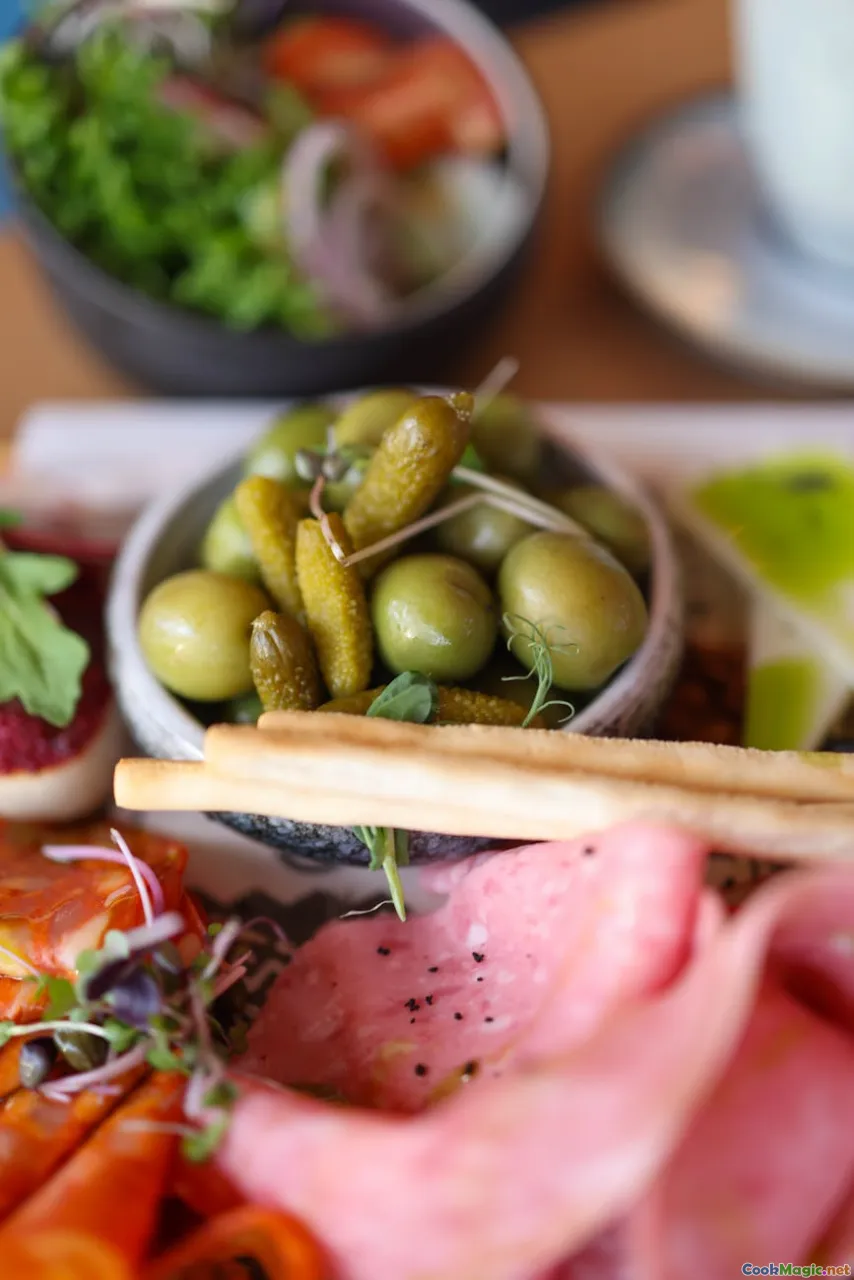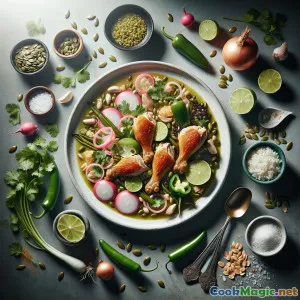
Prosciutto Colorato Guatemalteco per Tutte le Sante
(Colorful Guatemalan Fiambre for All Saints Day)
(0 Recensioni)0
1,159
luglio 14, 2025
Segnala un problema
Ingredienti
-
200 grams Barbabietola cotta affettata
(Barbabietole rosse o dorate, bollite e raffreddate)
-
150 grams Carote bollite
(Affettato)
-
120 grams Fagiolini
(Pulito e sbianchito)
-
120 grams Cavolfiore a cimette
(Parboiled fino a diventare croccante)
-
250 grams Petto di pollo
(Bollito, raffreddato e sminuzzato)
-
200 grams Prosciutto
(Affettato a fette sottili)
-
100 grams Salame
(affettato sottile)
-
80 grams chorizo
(Affettato a rondelle)
-
100 grams Formaggio marinato (queso fresco)
(Taglia a cubetti)
-
50 grams Baby mais in salamoia
-
60 grams Cipolle sottaceto
-
80 grams Cetriolini sottaceto
(Affettato)
-
80 grams Olive verdi
(Snocciolato)
-
80 grams Olive Nere
(Snocciolato)
-
4 large Uova
(Uovo sodo e tagliato in quarti)
-
1 bunch Prezzemolo
(Erbe fresche tritate per guarnire)
-
1 head Foglie di lattuga
(Lavato e intero)
-
200 ml Vinaigrette
(Miscela di olio d'oliva, aceto, un tocco di senape guatemalteca, pepe nero e origano)
-
2 tbsp Capperi
(Scolato e risciacquato)
-
3 medium Ravanelli
(Affettato sottile per decorazione)
(Barbabietole rosse o dorate, bollite e raffreddate)
(Affettato)
(Pulito e sbianchito)
(Parboiled fino a diventare croccante)
(Bollito, raffreddato e sminuzzato)
(Affettato a fette sottili)
(affettato sottile)
(Affettato a rondelle)
(Taglia a cubetti)
(Affettato)
(Snocciolato)
(Snocciolato)
(Uovo sodo e tagliato in quarti)
(Erbe fresche tritate per guarnire)
(Lavato e intero)
(Miscela di olio d'oliva, aceto, un tocco di senape guatemalteca, pepe nero e origano)
(Scolato e risciacquato)
(Affettato sottile per decorazione)
Nutrizione
- Porzioni: 10
- Dimensione Porzione: 1 piatto abbondante (350g)
- Calories: 360 kcal
- Carbohydrates: 19 g
- Protein: 22 g
- Fat: 19 g
- Fiber: 5 g
- Sugar: 6 g
- Sodium: 885 mg
- Cholesterol: 206 mg
- Calcium: 160 mg
- Iron: 2.7 mg
Istruzioni
-
1 - Preparare verdure e carni:
Pelare e bollire le barbabietole, le carote, i fagiolini e il cavolfiore. Raffreddare completamente. Cuocere e tritare petto di pollo, prosciutto e chorizo se necessario. Preparare tutte le carni e i formaggi affettandoli sottilmente o tagliandoli a cubetti per l'assemblaggio.
-
2 - Organizzare i gruppi di componenti:
Su un grande piatto o su più piatti, disponi le foglie di lattuga come base. Organizza gli ingredienti in mucchi ordinati e sovrapposti—ad esempio, barbabietole, medley di sottaceti, carni assemblate e formaggi—per creare strisce vivaci.
-
3 - Aggiungi Uova e Verdure Decorativi:
Taglia le uova sode a spicchi e disponile sulla insalata. Aggiungi fette di ravanello, cipolle sottaceto, mais e completa con olive e capperi per varietà di colore e sapore.
-
4 - Versare con vinaigrette:
Mescola insieme olio d'oliva, aceto, senape, pepe e origano. Versa leggermente su tutta l'insalata, assicurandoti che ogni gruppo di verdure, formaggi e carni sia coperto. Lascia amalgamare i sapori in frigorifero, coperto, per almeno 1 ora.
-
5 - Guarnire e Servire:
Prima di servire, cospargere con prezzemolo fresco tritato. Servire direttamente dal piatto di portata, assicurandosi che ogni piatto includa una sezione trasversale rappresentativa di sapori e consistenze.
Pelare e bollire le barbabietole, le carote, i fagiolini e il cavolfiore. Raffreddare completamente. Cuocere e tritare petto di pollo, prosciutto e chorizo se necessario. Preparare tutte le carni e i formaggi affettandoli sottilmente o tagliandoli a cubetti per l'assemblaggio.
Su un grande piatto o su più piatti, disponi le foglie di lattuga come base. Organizza gli ingredienti in mucchi ordinati e sovrapposti—ad esempio, barbabietole, medley di sottaceti, carni assemblate e formaggi—per creare strisce vivaci.
Taglia le uova sode a spicchi e disponile sulla insalata. Aggiungi fette di ravanello, cipolle sottaceto, mais e completa con olive e capperi per varietà di colore e sapore.
Mescola insieme olio d'oliva, aceto, senape, pepe e origano. Versa leggermente su tutta l'insalata, assicurandoti che ogni gruppo di verdure, formaggi e carni sia coperto. Lascia amalgamare i sapori in frigorifero, coperto, per almeno 1 ora.
Prima di servire, cospargere con prezzemolo fresco tritato. Servire direttamente dal piatto di portata, assicurandosi che ogni piatto includa una sezione trasversale rappresentativa di sapori e consistenze.
Ulteriori informazioni su: Prosciutto Colorato Guatemalteco per Tutte le Sante
The Story and Spirit Behind Guatemalan Fiambre Tradicional del 1 de Noviembre
If you've ever visited Guatemala during October’s end, you may encounter the dizzying scent of pickles, the tapestry-like color flashes of beets, peppers, green beans and eggs, all arranged magisterially onto platters that seem ablaze with edible confetti. This is Fiambre Tradicional del 1 de Noviembre—perhaps Guatemala’s most iconic cold salad and an appetizer, main dish, and centerpiece of memory-making all in one. It is joy, remembrance, unity, and family—flavors threaded across generations and afterlives.
Historical and Cultural Significance
Fiambre isn’t merely food. It’s a living quilt. This recipe has its roots deeply planted in colonial times with precedent in Spanish and Moorish antipasto. Over centuries, swept up through generations of Catholic influence and indigenous rituals honoring the dead, it emerged as Guatemala's commemorative Table of the Dead feast for Día de Todos los Santos (All Saints' Day, November 1st). Each family tweaks its own Fiambre recipe—an edible act of homage. Ingredients are selected not just for taste, but for their symbolic ties to deceased relatives: some meats for toughness (strength), eggs for life, and so on. Preparing Fiambre is a matter for consultation amongst ancestors—no two salads are ever truly the same from house to house or year to year.
Fiambre’s Unique Aspects
What sets Fiambre apart from anything you’ve tasted? It’s the sheer variety and balance. Cold, reserved vegetables (beets, cauliflower, carrots, beans, corn), prepared ahead and chilled, are an aromatic rainbow among finely sliced chorizo, salami, chicken, ham, and cheese. These are united with marinated vegetables like baby corn, capers, and myriad olives listed by the handful. Its vinaigrette, suffused with vinegar, smooth olive oil, Guatemalan mustard, oregano, sometimes even a trace of that family’s secret spice, soaks into the entire dish, marrying tang with the cooling mouthfeel and textural surprises.
After marinating, chilled for at least an hour, the dish is presented whole—a wild geometric layering of ingredients. Guests are served so each plate receives meat, veg, cheese, and garnish, welcoming all assembled and remembered. Some regions add seafood (fiambre rojo), while vegetarian takes exist (fiambre verde). Feel free to substitute local charcuterie or vegetarian sausages.
Preparing Fiambre at Home
Making fiambre is a task best done ahead—and even better as a collective event with family. Slice, cube, and allocate your components so that on an expansive platter, there’s visual order and balance: the slide of shining red beetroots laid against slices of pink ham, crisp florets of white cauliflower beside chartreuse gherkins, bright yellow pickled corn standing upright. Hard boiled eggs intersperse for softness, cheeses alternate for boldness. Set it all off with green herbs and savory vinaigrette.
It’s customary and practical to marinate the completed platter for an hour or more, giving flavors time to develop. Some even assemble it on October 31st, providing plenty of time for every meat and pickle to express its personality.
Serving and Personal Reflection
As a chef, few things are more gratifying than serving fiambre. The gasps from first-timers who marvel at the color story, followed by their beaming faces after the first bite—a taste surprising silky, bold, tart, sweet, deeply savory—illustrate its magic. Fiambre morphs the very idea of salad from a side act to main event; every version is a fingerprint for a family.
Beyond flavor, preparing fiambre brings people together: each person engaged at the table offers more than another set of hands—they put forward decades of memory and affection for those absent and present. It deepens one's respect for ancestors and celebrates identity—culinary, familial, and national. If you want to host a tradition that's intensely personal yet simultaneously inclusive, carve out a night this autumn for Fiambre.
Tips & Notes
- Advance preparation and refrigeration are key. Flavors improve overnight.
- Use a blend of fresh and pickled vegetables for authentic texture play.
- Don’t over-saturate with vinaigrette—drizzle lightly and allow guests to add their own.
- Arrange leftovers in jars—fiambre keeps well for days and develops increasingly complex flavors.
Honor, flavor, vivid memories, and the colors of life: that’s what awaits you in every bite of Fiambre Tradicional del 1 de Noviembre.
























